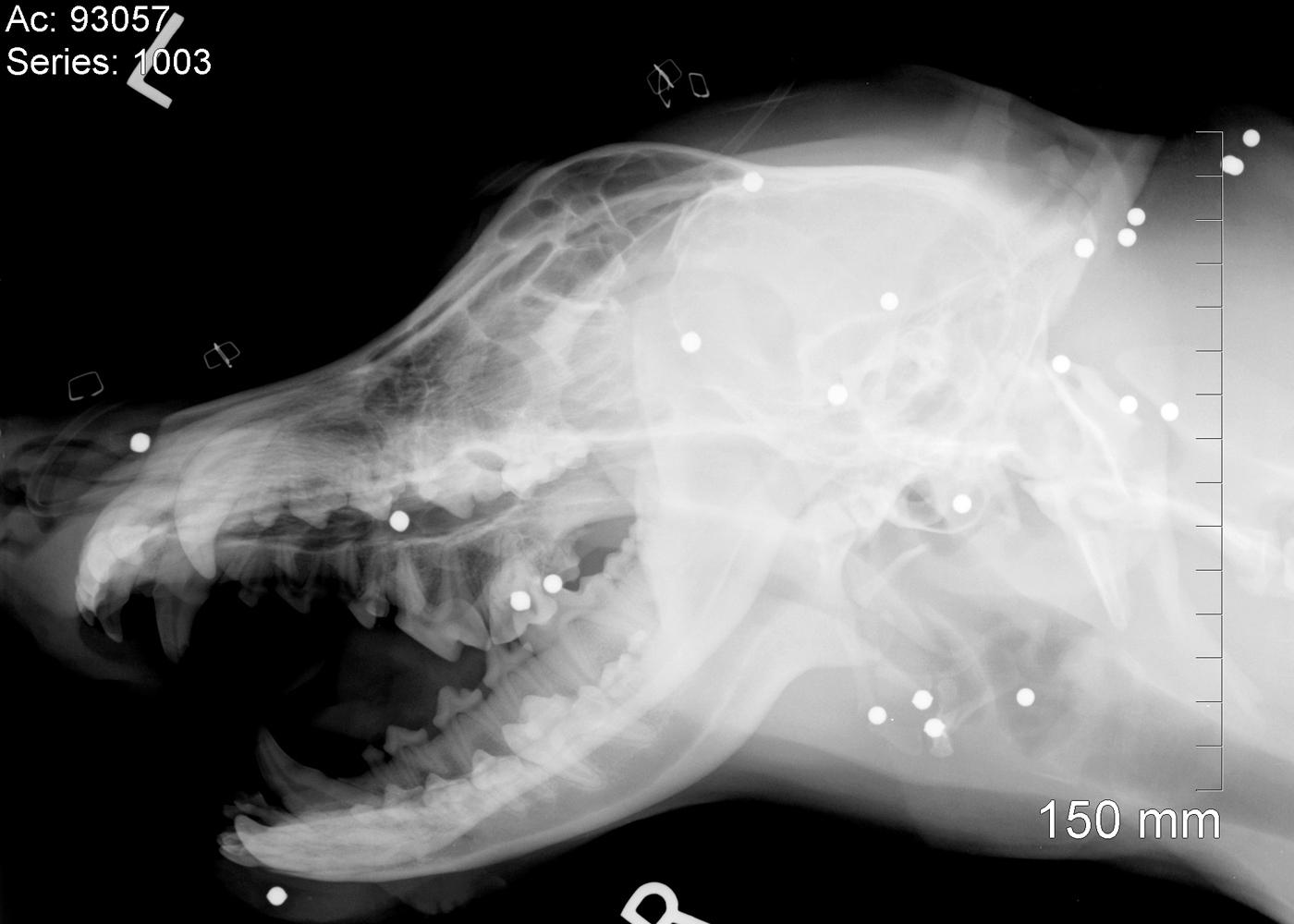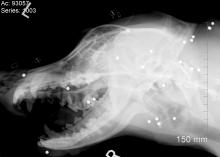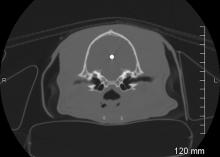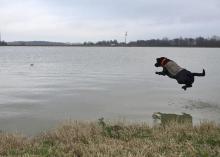Information Possibly Outdated
The information presented on this page was originally released on February 12, 2009. It may not be outdated, but please search our site for more current information. If you plan to quote or reference this information in a publication, please check with the Extension specialist or author before proceeding.
Pellet to the brain didn't stop one dog
MISSISSIPPI STATE -- A bullet to the brain usually means game over, but one young Labrador retriever beat the odds with the expert emergency help of a local veterinarian and Mississippi State University's College of Veterinary Medicine.
Tess is an 18-month-old female black lab who was accidentally shot in the head with a shotgun while duck hunting early one Sunday morning in December. She was in a near comatose state by the time her owner Steve Horn of Madison got her to the CVM emergency room four to five hours later.
“As soon as she was shot, she began swimming to me. I waded out to get her and scooped her up and we put her in a boat,” Horn said. “She got really cold and went into a deep shock, and we didn't know if we would lose her or not.”
Horn performed CPR on Tess and noted her rapid breathing but strong heartbeat. He had removed her protective vest to see her injuries, and he wrapped her in his heavy hunting coat to try to warm her as her body temperature dropped. Once back to his vehicle, he took Tess to Dr. Royann Leflore, who provided emergency after-hours care at the Greenwood Animal Hospital.
The staff in Greenwood warmed her, put her on steroids and antibiotics, and stabilized her with intravenous drips for the emergency truck ride to MSU.
“She was in bad shape, to say the least,” Horn said.
Dr. Christine Bryan, an intern in CVM's Clinical Sciences Department, was the primary veterinarian who managed Tess’ care. When she arrived, Tess was stretched out, weak in all four limbs, and had a rapid heart rate and breathing. Her head was swelling and her neck was extended unnaturally. Her eyes did not respond correctly.
“At the time of her arrival and assessment, I gave Tess a grave prognosis for survival and an even worse prognosis for a semi-normal life as a pet,” Bryan said. “I told the owners that if she survived, I felt that she would never be able to hunt again, but hopefully she would be able to be a house pet.”
Staff gave Tess medication to reduce brain swelling, sedate her and prevent seizures. They placed her on oxygen and gave intravenous fluids to maintain her blood pressure and keep her hydrated. She received pain medication and was radiographed.
“The skull radiographs revealed approximately 26 pellets around the skull,” Bryan said.
On the second day, Tess was more alert and responsive when her name was called. However, she was still unable to see with her left eye. A CT scan of her head showed a shotgun pellet in the dead center of her brain.
“The CT scan revealed that one pellet had penetrated her skull at about the middle left lateral aspect of her brain and was situated between the two hemispheres,” Bryan said. “If the pellet had not followed its exact trajectory, it could have caused more extensive brain damage, lacerated a blood vessel, penetrated both brain hemispheres or caused uncontrollable hemorrhage in the brain.”
The staff continued to give Tess medications to prevent seizures, to reduce brain swelling and to keep her sedated. She was given antibiotic ointment in both eyes to treat an ulcer on her left eye. That night she began eating a little bit.
By day three, Tess could curl into a typical resting dog pose, but she could neither sit nor stand. Staff continued her medications, intravenous fluids and oxygen, and Tess continued to eat soft food and began drinking water.
On day four, she pulled herself to a sitting position and an hour later began walking, although she was unsteady and her head tilted to the right. Doctors removed Tess' oxygen and took her off the seizure and brain swelling medications. She began oral antibiotics and continued to receive pain medication and antibiotic ointments in her eyes.
By the fifth day, Tess was walking with only a slight head tilt and could eat, drink and relieve herself normally. She was released to her owners on the sixth day with medications and specific instructions on how to continue her therapy and rehabilitation at home.
“She had improved so much in those six days that we determined she would be able to have a great quality of life,” Bryan said. “She still had some neurologic deficiencies, and was unsteady when she walked and did not appear confident when stepping up or down.”
When she left, Tess' prognosis was that she would be able to function well as a pet and possibly could run, swim and hunt again one day.
“For the first two weeks she was unstable on the wood floors at home and didn't want to go up steps, but she's totally normal now,” her owner said in February. “She is hunting again as good as ever and doesn't appear to know what happened to her.”
Horn said he was not surprised at Tess' recovery because of the care she received from both the Greenwood veterinarian and MSU's veterinary college, and because many people prayed for her throughout the experience.
“Mississippi State's vet school was absolutely incredible, and she had a lot of prayers and is 100 percent recovered,” Horn said. “Her care wasn't just good; it was superb.”
Bryan, Tess' MSU veterinarian, said Tess would not have survived without the care she received in Greenwood and at MSU. She looked great at her three-week checkup in early January.
“She had a slight head tilt and mild incoordination, but she was getting around well. She was bright and alert and wagging her tail and was very excited to get her duck decoy to carry around the hospital with her,” Bryan said.
Dr. Andrew Mackin, service chief of CVM's Small Animal Internal Medicine department, said Tess benefitted from the veterinary college's emergency service and the specialized care she received during her recovery. At CVM, Tess received round-the-clock care and supervision, and had the advantage of expertise and state-of-the-art equipment.
“The MSU College of Veterinary Medicine's Intensive Care Unit is one of the few 24-hour care and emergency veterinary facilities in Mississippi, and the only facility offering tertiary-level (specialized) care of referred small animal patients,” Mackin said.
Owner Horn learned one lesson from the ordeal.
“Everyone should have an emergency plan when they go out hunting. I had no idea what to do when the accident happened,” he said. “Everybody should know where the nearest veterinarian is located and have an emergency phone number for the clinic. They also should have an emergency plan and know how to contact the vet school.”
Contact: Dr. Christine Bryan, (662) 325-3432






